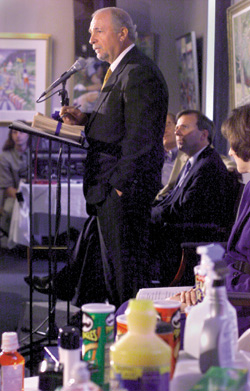
Dr. Harry Jacobson addresses the crowd at the P&G announcement as Mayor Bill Purcell listens. (photo by Dana Johnson)
New device enhancing results
for atrial fibrillation patients
Vanderbilt University Medical Center’s Arrhythmia Clinic is making strides to increase the number of therapies available to arrhythmia patients, specifically those suffering from atrial fibrillation or an irregular rapid heart beat.
As physicians are seeing the effectiveness of traditional modalities wane, they are no longer solely depending on these medicinal forms of treatment. Instead, they are looking to pacemakers as an adjunct to more traditional pharmacological therapy. They will be used with medications as needed.
Traditionally, pacemakers have been used in the treatment of arrhythmias but only targeted the problem of slow heart rates.
A new device utilizes the same pacemaker but has a software program that incorporates a form of pacing that allows for an automatic synchronization of the heart rhythms. Doctors are finding that this enhanced device is making a difference in atrial fibrillation patients.
“By pacing in this fashion, we may be able to prevent the triggers that cause atrial fibrillation,” said Dr. Mark S. Wathen, assistant professor of Medicine and director of the Electrophysiology Lab at Vanderbilt.
“The pacing has a special technique where it learns what an individual patient’s rhythm is and paces accordingly,” he says. “It paces the heart purposefully. It is programmed to pace each heart beat to learn the sinus rates.”
In the past, atrial fibrillation was treated with drugs to prevent the rapid randomized contractions of the heart, but doctors have found that form of treatment only works about 50 percent of the time.
Vanderbilt is one of 22 centers enrolling patients in a Pacesetter study called Adopt-A Trial. This two-year study is designed to test the effectiveness of the new pacemaker software.
“Something needs to be done for this form of cardiac disease,” Wathen said. “The current therapy is not always effective and drug toxicity is possible and can lead to death. With this in mind, we must find an alternative for patients who have had to accept atrial fibrillation and the risk of stroke that these fast heart beats impose.”
Vanderbilt’s emphasis on the treatment of atrial fibrillation has also put the medical center in another trial testing a pacemaker’s ability to actually terminate a rapid heart rhythm.
This trial, AT500 using Medtronic devices, will look at the possibility of programming a pacemaker to not only prevent a fast heart rate, but to terminate it.
“It will first try to prevent the fast heart rate. If it is not successful, it will then attempt to terminate it,” Wathen said. “If the device is pacing faster than the heart, it will capture the pace and extinguish it automatically.
“Atrial fibrillation is generally considered not pace terminable, but it may be in its early stages. We may be able to see that a different rhythm causes the initiation of atrial fibrillation and that particular rhythm is terminable.”
Vanderbilt is the only center enrolled in both studies, Wathen said. The Medtronic trial, which Wathen helped design, is a crossover study that allows the patients to be randomized to both arms of the study at half of the time with the pacemaker on and half of the time with the device turned off.
“This approach allows us to really determine the benefits of the therapy by using the outcomes of each patient’s response during both arms,” Wathen said.
The use of pacemakers in the treatment of atrial fibrillation is the first time that the medical community has shifted away from pharmacological therapy, Wathen said.
Another treatment Vanderbilt physicians are studying in hopes of offering more choices for atrial fibrillation patients is RF Ablation, which uses radio frequency to burn the specific site of focus for the irregular rhythms.
This treatment modality is typically used to treat other forms of tachycardias or rapid heart rates. Doctors are now hopeful that it can help alleviate the source of atrial fibrillation in patients also.
In recent years, doctors have discovered that there is a specific focus for atrial fibrillation. With that understanding, it is possible to ablate or burn that specific site of initiation by putting radio frequency into a catheter, burn a hole the size of a pencil lead and eliminate the focus.
“This is a big breakthrough,” Wathen said. “It is important because we are reconsidering the mechanism of atrial fibrillation. RF ablation is also a cure. There has never been a cure, only palliative treatment.
“There is a significant percentage of atrial fibrillation patients unsuccessfully treated with anti-arrhythmic medications resulting in strokes. Any success using RF ablation greater than zero represents improvement.
“Our current success rate is 60 percent,” he said. “We hope to improve upon this number over the next few years.”
With more than four million Americans suffering with atrial fibrillation, Wathen is encouraged by the current trials testing the various treatment options.













